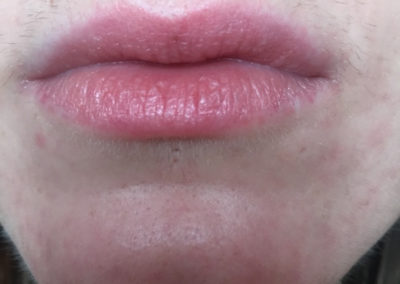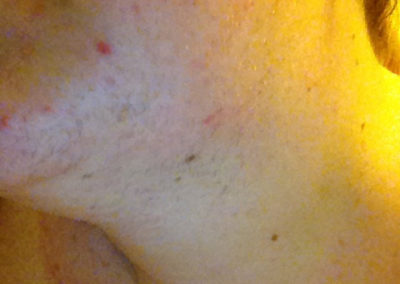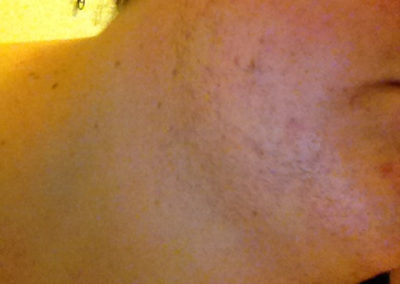Hirsutism
Medically reviewed by The Dermatologists and written by Dr. Carol Mastropierro and Dr. Alexander Börve
Uncommon
- It is a male pattern of hair growth in women
- Hirsutism affects approximately 10% of women in Western societies especially in those of Mediterranean or Middle-Eastern descent. It is often related to hormonal disbalance
- Commonly affected areas are upper lips, chin, central chest, midline of the stomach, lower back, buttocks, and thighs
- Hormonal testing and hormonal replacement therapy can aid in resolving the condition
- Laser, IPL or electrolysis are commonly used for permanent hair removal in absence of metabolic disorders
Hirsutism is a condition affecting females worldwide. It is a male pattern of hair growth occurring in women. This means women with hirsutism grow thick and coarse hair on limbs, trunk and face.
Hirsutism is to be differentiated from hypertrichosis, a condition with generalized excess body hair and not in a gender specific pattern of growth. Hirsutism can be isolated or be a sign of hormonal imbalance. Blood tests may be required by your doctor to set a diagnosis.
Consult an online dermatologist today and get an answer on your skin concern within hours.
Symptoms
Hirsutism can involve a single site or multiple sites. Commonly affected areas are upper lips, chin, central chest, midline of the stomach, lower back, buttocks and front of thighs. Hirsutism is relatively common, as it affects approximately 10% of women in Western societies. This condition tends to get worse as women get older.
Hirsutism presents with:
- Facial hair: moustache, beard, bushy eyebrows or synophrys (unibrow)
- Abdomen: pubic hair extends along the linea alba and around the umbilicus
- Chest: can be limited to the area around the nipples or have a more extensive growth
- Back: mostly in the upper back and lower back and buttocks area
- Thighs: mostly front and inner thigh
If hirsutism is related to high androgens levels, you may also experience other signs of virilization, including:
- Deepening of the voice
- Acne
- Increase in muscle mass
- Male pattern alopecia (temporal and or apical hair loss)
The severity of hirsutism is assessed using the Ferriman-Gallwey visual scale or a modified version, which assesses 9 areas of the body. The score varies from 0 (no hair) to 4 (extensive hair growth) in each area.
Total score < 8: normal hair growth
Total score 8–14: mild hirsutism
Total score ≥ 15: moderate to severe hirsutism
Consult an online dermatologist today and get an answer on your skin concern within hours.
What can I do?
Hirsutism can be distressing as some women may feel distressed and self-conscious about having excess body hair. Self-care methods such as plucking, waxing and bleaching can help in temporarily removing or reducing the appearance of unwanted facial and body hair. Permanent hair removal through laser or electrolysis can be considered. However, if you have risk factors including obesity, diabetes, cushing syndrome or family history of metabolic diseases, you might want to see a doctor in order to exclude an endocrine origin of your body hair.
Consult an online dermatologist today and get an answer on your skin concern within hours.
Should I seek medical attention?
If you feel like you have excess body and facial hair, you might want to talk to your doctor to exclude that hirsutism is a symptom of a hormonal imbalance. You may either see your GP, endocrinologist, or Dermatologist. Our online dermatologists can help you by giving you a quick and easy assessment.
Hirsutism can either be primary, meaning it is not caused by any other condition, or secondary if it is associated with:
- Polycystic ovary syndrome (PCOS).
- Congenital adrenal hyperplasia
- Cushing syndrome
- Medications- such as Testosterone supplements, corticosteroids, Danazol (medication for endometriosis treatment.)
Treatment
Treatment options will be based upon whether your Hirsutism is primary or secondary.
Primary hirsutism is benign and does not require any treatment if not for cosmetic purposes. Plenty of temporary and permanent hair removal are available. These include shaving, hair removal creams, waxing and bleaching. Permanent hair removal can be achieved by a professional trained in laser removal or electrolysis removal.
Secondary hirsutism needs to be addressed in the light of the primary disease. Hormonal replacement therapy and disease specific treatments will eventually ease or completely resolve the excess body hair. Medical treatment includes the use of creams slowing hair growth, such as
- Eflornithine cream. It is not a depilatory cream. It is placed on the skin to inhibit hair growth and it will take two to three months of regular use to see a difference. Continued treatment is needed to maintain beneficial effects.
Side effects are usually mild and include burning or stinging of the skin and acne.
- Anti-androgens. They work by blocking the action of the androgens that can cause hirsutism. Hair growth will slow after 4-6 months, and the hairs will gradually become thinner and less noticeable; the problem, however, tends to return when medication is stopped. Anti-androgens include:
- Oral contraceptives.
- Spironolactone. This a water tablet (diuretic) that also decreases the levels of androgens.
- Finasteride. This drug is commonly used to treat benign prostatic hyperplasia BPH, and male-pattern baldness. Finasteride blocks the enzyme responsible for conversion of testosterone in its active form. It is not licensed for treating hirsutism in the UK. Its usage should be restricted to postmenopausal women.
Consult an online dermatologist today and get an answer on your skin concern within hours.
Source:
Sachdeva S. Hirsutism: evaluation and treatment. Indian J Dermatol. 2010;55(1):3-7. doi:10.4103/0019-5154.60342
British Association of Dermatologists’ Patient Information Lay Review Panel
Hafsi W, Badri T. Hirsutism. [Updated 2020 Apr 27]. In: StatPearls [Internet]. Treasure Island (FL): StatPearls Publishing; 2020 Jan-. Available from: https://www.ncbi.nlm.nih.gov/books/NBK470417/
Ask a Dermatologist
Anonymous, fast and secure!

The Specialist doctor from the University Hospital in Gothenburg, alumnus UC Berkeley. My doctoral dissertation is about Digital Health and I have published 5 scientific articles in teledermatology and artificial intelligence and others.




